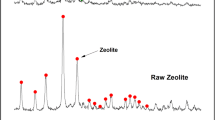Abstract
Triclosan (TCS) adsorption behavior by a modified zeolite with Cetyl Trimethyl Ammonium Bromide (CTAB) was evaluated factoring in pH, contact time, and TCS initial concentration in a batch system. Natural clinoptilolite-type zeolite from Sonora, Mexico was conditioned with a sodium chloride solution, and, subsequently, modified with CTAB. All the zeolites were characterized by X-ray Diffraction (XRD), Fourier Transform Infrared Spectroscopy (FTIR), Scanning Electron Microscopy (SEM), Electron Dispersive Spectroscopy (EDS), and the Zero Point Charge (pHZPC). It was found that the morphological and structural properties of natural zeolite were not affected after treatment with cationic surfactant. Furthermore, adsorption process efficiency was enhanced by the presence of CTAB, obtaining TCS maximum adsorption capacity at an optimal pH of 9.0. In this context, the positively charged surface of the modified zeolite and the anionic triclosan species present were decisive. Kinetics data were well adjusted to a pseudo-second order model with a TCS adsorption capacity of 1.430 ± 0.051 mg g−1 at an equilibrium time of 18 h. Isotherm results were best adjusted to the Langmuir model with a qmax = 2.027 mg g−1 using an initial Co concentration of 18.0 mg L−1, and reaching an equilibrium Ce concentration of 0.559 mg L−1. The mechanism for the adsorption of TCS by CTAB-modified zeolite was proposed to be electrostatic attractions between the group of partial positive charge of CTAB and the anionic species of triclosan. Consequently, CTAB-modified zeolites could be used as effective adsorbents for triclosan removal.
Similar content being viewed by others
References
Q. Sui, X. Cao, S. Lu, W. Zhao, Z. Qiu, and G. Yu, Emerg. Contam. 1, 14 (2015).
J. Fu, Y. X. R. Tan, Z. Gong, and S. Bae, Ecotoxicol. Environ. Saf. 189, 110039 (2020).
F. L. Nassan, Environ. Res. 177, 108633 (2019).
S. K. Behera, S. Y. Oh, and H. S. Park, J. Hazard. Mater. 179, 684 (2010).
C. Lei, Y. Hu, and M. He, Chem. Eng. J. 219, 361 (2013).
S. Alvarez-García, J. J. Ramírez-García, F. Granados-Correa, and J. C. Sánchez-Meza, Water, Air, Soil Pollut. 229, 347 (2018).
P. Barragán P., M. G. Macedo M., and M. T. Olguín, J. Environ. Sci. (China) 52, 39 (2017).
D. Ruiz-Serrano, M. Flores-Acosta, E. Conde-Barajas, D. Ramírez-Rosales, J. M. Yáñez-Limón, and R. Ramírez-Bon, J. Mol. Struct. 980, 149 (2010).
M. Dávila-Estrada, J. J. Ramírez-García, M. J. Solache-Ríos, and J. L. Gallegos-Pérez, Water. Air. Soil Pollut. 229, 123 (2018).
M. Dávila-Estrada, J. J. Ramírez-García, M. C. Díaz-Nava, and M. Solache-Ríos, Water. Air. Soil Pollut. 227, 157 (2016).
S. Alvarez-García, J. J. Ramírez-García, F. Granados-Correa, and J. C. Sánchez-Meza, Sep. Sci. Technol. 55, 619 (2020).
S. Fukahori, T. Fujiwara, R. Ito, and N. Funamizu, Desalination 275, 237 (2011).
A. González-Ortiz, J. J. Ramírez-García, and M. J. Solache-Ríos, Desalin. Water Treat. 127, 243 (2018).
M. G. Macedo-Miranda, and M. T. Olguín, J Incl Phenom Macrocycl Chem. 59, 131 (2007)
A. Peña-Álvarez, and A. Castillo-Alanís, TIP.18, 29 (2015).
Acknowledgments
The authors are grateful to the Technological National of Mexico (TecNM), and LIIA for financial support. Sonia Alvarez-García (CVU, professional ID: 553982) expresses her gratitude to the CONACyT for the postdoctoral scholarship.
Author information
Authors and Affiliations
Rights and permissions
About this article
Cite this article
Alvarez-García, S., Macedo-Miranda, G., Martínez-Gallegos, S. et al. Removal of triclosan by CTAB-modified zeolite-rich tuff from aqueous solutions. MRS Advances 5, 3257–3264 (2020). https://doi.org/10.1557/adv.2020.394
Published:
Issue Date:
DOI: https://doi.org/10.1557/adv.2020.394




